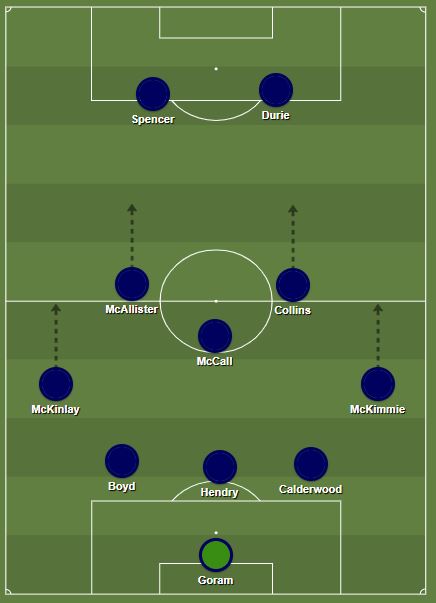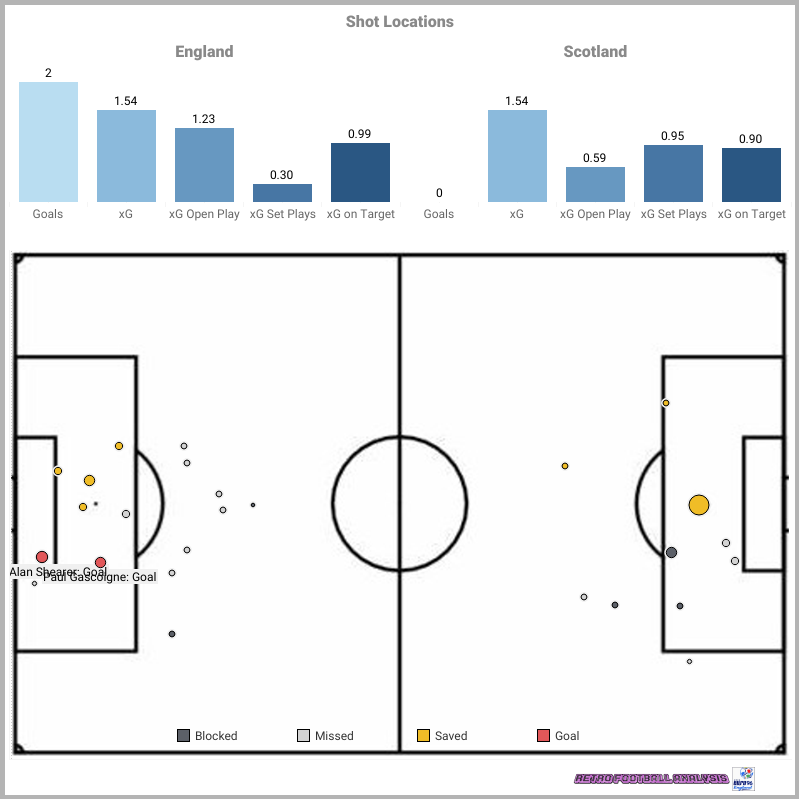England’s system of play would alter during the match, however the basic premise was a 3-5-2 system as illustrated below.
The pivot point in the midfield was taken up by Southgate, how would press forward with the midfielders, but could also drop back into defense when required.
Neville and Pearce were given license to attack the wide areas like full backs, or provide early service into the box for the strikers to feed off combinations.
McManaman would attack on the left in the first half, but on the right in the second, each time dribbling diagonally to create 2v1 situations with his advancing full back overlapping him.
Anderton would supply a similar role to Mcmanaman but was more of a foil for Gascoigne to combine and allow him to make forward runs into the final third.
Sheringham and Shearer performed well as a pair, each of them given license to drop into pockets to pick up the ball while the other stretched spaces in behind.
England Starting X1

Scotland set up in 532 formation, attempting to protect the spaces across the width of the field in the final third, but also to create forward transitions into the channels for Spencer and Durie to feed off of. Durie dropping gave Scotland extra security, at times forming 5-4-1 defensive structure to prevent McManaman dribbles.
McAllister was charged with getting forward to link with Durie, making numerous attacking runs from deep to do so.
Collins would use his wing backs to combine and make outside movements to break space, but also to serve as a means of switching the ball should they get outnumbered.
Scotland Attacking Structure

WHAT DO THE NUMBERS TELL US?

Value of Chances
xG Timeline:
If we consider the context of this match, the pressure, the rivalry, the need to win, it allows to view this match with a degree of understanding that helps shape the narrative. Overall this game wasn’t the most aesthetically pleasing, nor did it provide us with very many high quality attacks, but if we consider the flow of the game the period between 50 & 80 minutes was absolutely critical. For the 1st fifty minutes it was a very even affair, but Shearer’s goal saw England capitalize on a goal from a run of 6 unanswered attacks. Conversely Scotland would have their own purple patch with 4 unanswered attacks, but the penalty miss and subsequent Gascoigne goal would effectively end the game as a contest.
Chance Quality:
England certainly created more clear-cut chances in this match, despite us seeing each team return the same expected goals. England would create three big chances in the match, all of which landed on target and two would result in a goal, where as Scotland’s only big chance came from their penalty which Seaman would save. If we take out Scotland’s penalty out of the equation it changes the picture dramatically, as England would be on course to better Scotland by almost double with non-penalty xG in the match. Scotland simply did not create enough to genuinely threaten on chances alone, however given the probability of the penalty there is no doubt McAllister missing changed the course of the game completely.
Type of Chances Created

Similar to their opening game England would favor an approach play that was from wide areas and supplied via crosses into the box. England’s control of the ball was better in this game, as Southgate’s movement into midfield allowed them to cover more of the central channel and as such progress the ball with more security to create chances with. They relied far less on Gascoigne’s combination play, and instead gave license to McManaman to move inside and overload the Scotland midfield completely. Of England’s 10 attacks through build up play 5 would result in shots on target, better yet two of these five would result in goals. While England have been successful in this match there may be a slight apprehension that they aren’t creating enough chances from inside, or certainly closer to, the 18 yard box, but for how they are setting out to play they are getting the rewards from it.
Scotland’s attack play was hampered by an over placement of true defenders in wide areas, both of whom lacked any real quality when going forward. A more functional midfield endeavored to work hard, and did well to build 6 attacks overall, but their approach play is often undermined by a desperate lack of penetration. Of the 4 Scotland attacks that came from a key pass, three were from crosses and one from a headed pass. Very few are preceded by a dribble or a through pass, which is allowing their opponent to keep the game in front of them for large periods. Further evidence of this was that from the 6 attacks Scotland have during build up play, only 1 of them would result in a shot on target, quite simply the lacked a genuine threat despite scoring what was a decent xG score.
Where Chances are Created

England would again attack from inside the box 8 times (the same number of times as they would get against Switzerland) but this time would hit the target on 6 of those 8 occasions (last time they only hit 4). Whats interesting to note was that all 8 of England’s attacks outside the box were off target, therefore suggesting that they do their best work when creating attacks for their strikers, from crosses, inside the 18 yard box. While England out performing their xG would suggest an element of luck, if anything England could put forward a case of being disappointed at not scoring more. Their big chance count suggests that their attack play was solid, with 7 attacks inside the golden zone 6 of which on target. Added to this 65% of England’s xG score comes from chances which ended up on target, so overall England can be happy with their 2nd half performance which returned two very good goals.
When we evaluate Scotland’s shot locations and value this is where we get a real feel for their attacking output. The penalty did hit the target, which will naturally skew the numbers slightly, but examining the rest of their attacks gives us a better picture of the performance. Removing the penalty score we see that the sum total of their on target attack play was 0.14, therefore they gave themselves a 14% chance of scoring, whereas England’s same probability came in at 65%. There is no doubt that the penalty changed the course of the game, however if Scotland are to progress from the group that have to build a more coherent attacking threat, and one that increases the quality of the shots not necessarily the quantity.
Who Created Chances
England’s best statistical attacker was Alan Shearer. Tip of the hat goes to Sheringham who ran Shearer close, however the opening goal would be the dividing factor. Shearer would be involved in 5 attacks overall, hitting two attacks of his own on target and creating 1 other which a teammate would hit on target. His xG return for the match was 0.51, which accounted for a third of England’s attack value.
Scotland’s best performer was Gary McAllister, who was a ways in front of the rest of his teammates. He was involved in 3 of Scotlands attacks, hitting one shot from open play, one set piece on target and his penalty would hit the target but was met by the out-stretched arm of David Seaman. The penalty takes his xG to 1.04 overall, so on another day he could be coming away with a goal and a different scoreline.
Match Predictor
Using our very own Retro Football Analysis Match Simulator, we use the probability rating of each attack to calculate the odds of the matches outcome. Here are the results we got back.

Our verdict:
Arguably one of the more bizarre results we’ve found during our analysis of the tournament, however its all boils down to your interpretation of penalty kick probability. Ultimately a team who gets one should score more often than not, therefore it should give Scotland the advantage in this match. As it turned out its result would end up helping their opponent, as in the moments after the kick Anderton and Gascoigne would combine to hit Scotland when it hurt the most.


